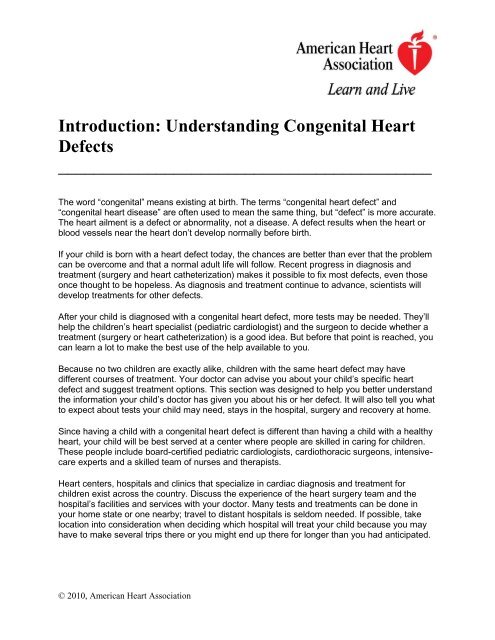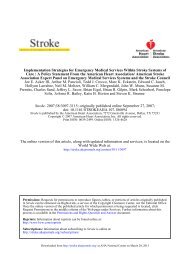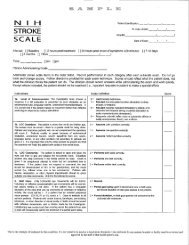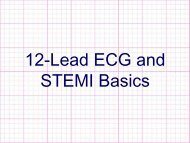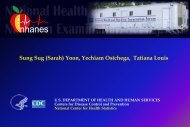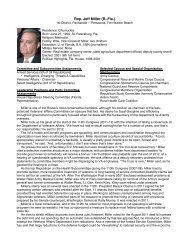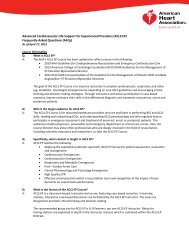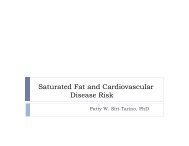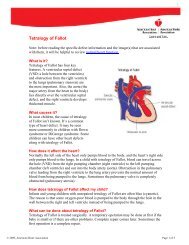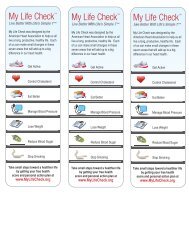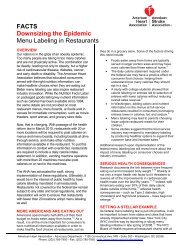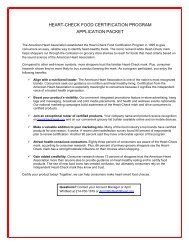Introduction to Congenital Heart Defects - American Heart Association
Introduction to Congenital Heart Defects - American Heart Association
Introduction to Congenital Heart Defects - American Heart Association
Create successful ePaper yourself
Turn your PDF publications into a flip-book with our unique Google optimized e-Paper software.
<strong>Introduction</strong>: Understanding <strong>Congenital</strong> <strong>Heart</strong><br />
<strong>Defects</strong><br />
__________________________________________<br />
The word “congenital” means existing at birth. The terms “congenital heart defect” and<br />
“congenital heart disease” are often used <strong>to</strong> mean the same thing, but “defect” is more accurate.<br />
The heart ailment is a defect or abnormality, not a disease. A defect results when the heart or<br />
blood vessels near the heart don’t develop normally before birth.<br />
If your child is born with a heart defect <strong>to</strong>day, the chances are better than ever that the problem<br />
can be overcome and that a normal adult life will follow. Recent progress in diagnosis and<br />
treatment (surgery and heart catheterization) makes it possible <strong>to</strong> fix most defects, even those<br />
once thought <strong>to</strong> be hopeless. As diagnosis and treatment continue <strong>to</strong> advance, scientists will<br />
develop treatments for other defects.<br />
After your child is diagnosed with a congenital heart defect, more tests may be needed. They’ll<br />
help the children’s heart specialist (pediatric cardiologist) and the surgeon <strong>to</strong> decide whether a<br />
treatment (surgery or heart catheterization) is a good idea. But before that point is reached, you<br />
can learn a lot <strong>to</strong> make the best use of the help available <strong>to</strong> you.<br />
Because no two children are exactly alike, children with the same heart defect may have<br />
different courses of treatment. Your doc<strong>to</strong>r can advise you about your child’s specific heart<br />
defect and suggest treatment options. This section was designed <strong>to</strong> help you better understand<br />
the information your child’s doc<strong>to</strong>r has given you about his or her defect. It will also tell you what<br />
<strong>to</strong> expect about tests your child may need, stays in the hospital, surgery and recovery at home.<br />
Since having a child with a congenital heart defect is different than having a child with a healthy<br />
heart, your child will be best served at a center where people are skilled in caring for children.<br />
These people include board-certified pediatric cardiologists, cardiothoracic surgeons, intensivecare<br />
experts and a skilled team of nurses and therapists.<br />
<strong>Heart</strong> centers, hospitals and clinics that specialize in cardiac diagnosis and treatment for<br />
children exist across the country. Discuss the experience of the heart surgery team and the<br />
hospital’s facilities and services with your doc<strong>to</strong>r. Many tests and treatments can be done in<br />
your home state or one nearby; travel <strong>to</strong> distant hospitals is seldom needed. If possible, take<br />
location in<strong>to</strong> consideration when deciding which hospital will treat your child because you may<br />
have <strong>to</strong> make several trips there or you might end up there for longer than you had anticipated.<br />
© 2010, <strong>American</strong> <strong>Heart</strong> <strong>Association</strong>
Incidence of congenital heart defects<br />
Most people are unaware that up <strong>to</strong> 1.3 million <strong>American</strong> alive <strong>to</strong>day have some form of<br />
congenital heart defect and about one-half of these individuals are less than 25 years of age.<br />
At least nine of every 1,000 infants born a year have a heart defect. That’s almost one percent<br />
of live-born infants. Sometimes the defect is so mild that there are no outward symp<strong>to</strong>ms. In<br />
other cases, it’s so severe that the newborn becomes ill soon after birth. In still other cases,<br />
signs and symp<strong>to</strong>ms occur only in later childhood.<br />
In the United States, about 36,000 children are born with a heart defect each year. Most of<br />
these children can be helped by surgery even if the defect is severe.<br />
How congenital heart defects develop<br />
You may wonder why your child has a congenital heart defect. <strong>Congenital</strong> heart defects do not<br />
occur in a majority of children, and when they do occur, often there is no known cause. Because<br />
of this, in most cases there is nothing the parents could have done differently <strong>to</strong> prevent the<br />
heart defect. <strong>Congenital</strong> heart defects strike without regard <strong>to</strong> socio-economic status, race or<br />
cultural background. Don’t feel it’s your fault that your child has this problem.<br />
<strong>Heart</strong> defects, especially those occurring as isolated problems in otherwise healthy infants,<br />
generally don’t have readily identifiable genetic or environmental causes. Some error occurs<br />
early in the formation and growth of the heart when the fetus is developing that causes the<br />
defect.<br />
Several genetic syndromes (such as Down, DiGeorge, Williams, Alagille, and Noonan<br />
syndromes) have cardiac malformations as well as defects in other organ systems. In some<br />
cases, a gene defect has been identified that causes the syndrome. For instance, in Down<br />
syndrome there is an extra chromosome 21 in each cell of the body (trisomy 21). In other<br />
syndromes, a genetic cause has not yet been established. These facts all point <strong>to</strong> a genetic<br />
component <strong>to</strong> the occurrence of congenital heart defects.<br />
Numerous maternal environmental exposures early in pregnancy are also associated with<br />
congenital heart defects. These include the use of some medications for seizures, acne or<br />
bipolar psychiatric disorder, or having rubella (German measles), other viral diseases, or<br />
maternal conditions such as phenylke<strong>to</strong>nuria and diabetes. Alcohol abuse and street drugs, as<br />
well as exposure <strong>to</strong> certain chemicals, have also been associated with heart defects, <strong>to</strong>o.<br />
Depending on the defect, the chances of a sibling also being born with the same or another<br />
heart defect are about 2 <strong>to</strong> 3 percent. While this is higher than the general population rate of<br />
about 1 percent, it’s still a relatively small chance. Although exact causes for most congenital<br />
defect aren’t known, remaining healthy and avoiding certain exposures may be helpful. If you or<br />
your partner does become pregnant again, tell your obstetrician about your other child. Fetal<br />
echocardiograms (ultrasounds) may help detect problems as early as mid-pregnancy.<br />
© 2010, <strong>American</strong> <strong>Heart</strong> <strong>Association</strong>


